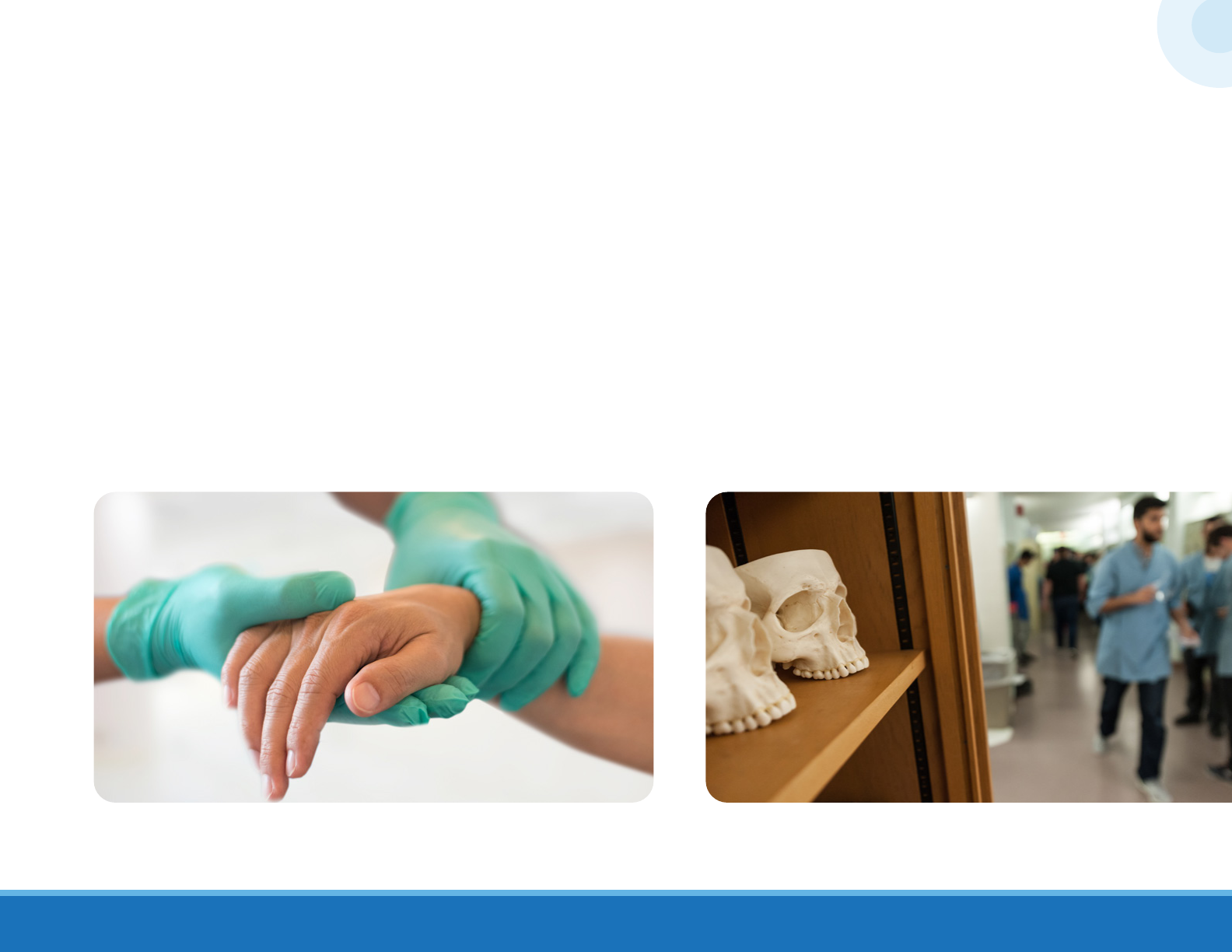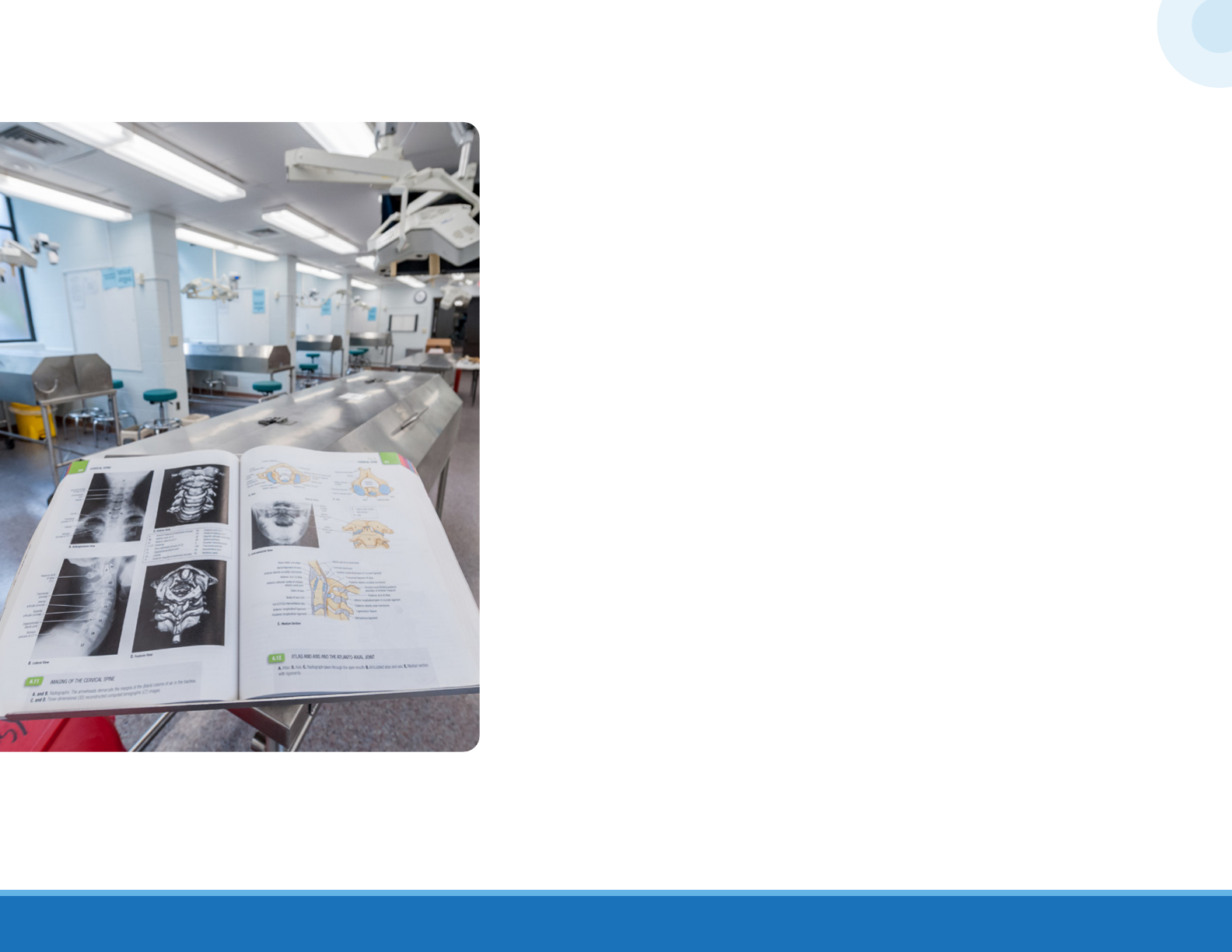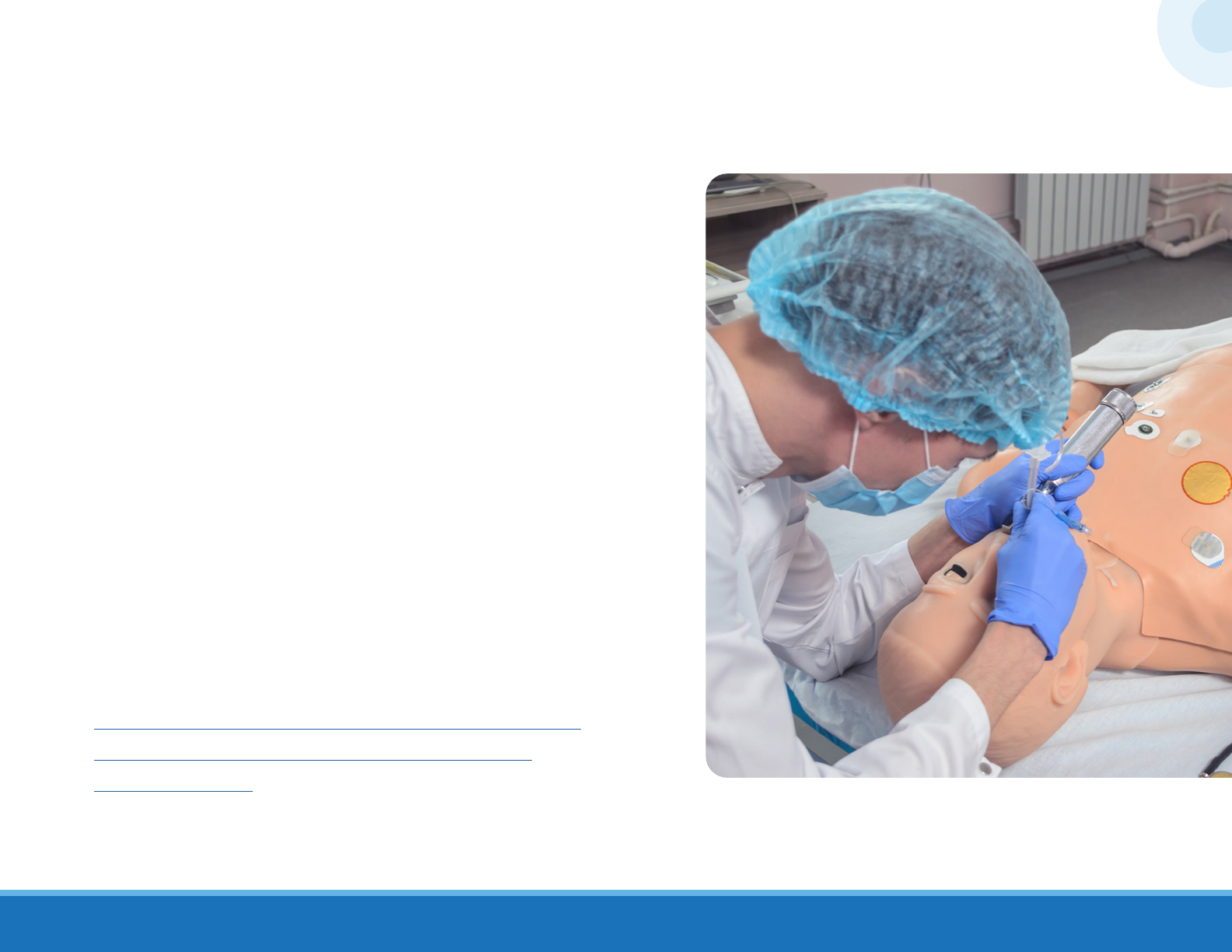
A NEW DEGREE OF CARE |
HOW TO BECOME AN
ANESTHESIOLOGIST ASSISTANT

A CRUCIAL PART OF
THE CARE TEAM: BECOME
AN ANESTHESIOLOGIST
ASSISTANT
01
A CRUCIAL PART OF THE CARE TEAM: BECOME AN ANESTHESIOLOGIST ASSISTANT 3
CLICK TO RETURN
TO TABLE OF CONTENTS
The College of Graduate Studies at Northeast Ohio Medical
University is designed for students who want to advance
community health in northeast Ohio and beyond. If you are
interested in a fullling and nancially rewarding career as
a Certied Anesthesiologist Assistant (CAA), the College of
Graduate Studies at NEOMED will prepare you to change your
community for the better while providing essential patient care.
This guide will provide more information about the growing field
of Anesthesiologist Assistants, what to expect as a CAA and how
to begin your education. Let’s get started!

4
CLICK TO RETURN
TO TABLE OF CONTENTS
Certified Anesthesiologist Assistants (CAAs) are healthcare professionals with extensive training in the delivery
and maintenance of quality anesthesia care and advanced patient monitoring techniques. All CAAs work exclusively
within an anesthesia care team environment, under the supervision of a licensed anesthesiologist.
CAAs are an essential part of the anesthesia care team. They provide an increased level of patient safety and care
across the spectrum of surgical specialties. Additionally, licensed Anesthesiologists who work alongside CAAs are
able to implement anesthesia care plans in multiple operating rooms simultaneously. This allows doctors to provide
more surgeries in less time, reducing the amount of time patients must wait for necessary procedures.
WHAT IS AN ANESTHESIOLOGIST ASSISTANT?
A CRUCIAL PART OF THE CARE TEAM: BECOME AN ANESTHESIOLOGIST ASSISTANT

5
CLICK TO RETURN
TO TABLE OF CONTENTS
If you have ever had surgery or another procedure requiring anesthesia, you might have noticed how much thought
and work goes into ensuring a patient’s safety and comfort before, during and after their procedure.
Certified Anesthesiologists Assistants (CAAs) are relied upon to provide routine, complex and essential
perioperative care in a variety of patient settings, including preoperative clinics, ambulatory surgery centers and
large hospitals.
As highly-trained health care professionals, CAAs are well-prepared to care for patients at every stage of the
anesthesia care plan. CAAs provide preoperative patient consults, prepare patients for surgery, and even perform
life-saving measures when necessary.
As an Anesthesiologist Assistant, your duties are likely to include:
WHAT DOES AN ANESTHESIOLOGIST ASSISTANT DO?
• Administering diagnostic tests (i.e. drawing and interpreting labs, etc.)
• Establishing IV access
• Performing intubations and other airway management maneuvers
• Taking a complete patient history or performing physical exams
• Pre-testing and calibrating anesthesia delivery systems and monitors
• Monitoring the patient throughout the entire surgical procedure, giving medications and blood products as needed
A CRUCIAL PART OF THE CARE TEAM: BECOME AN ANESTHESIOLOGIST ASSISTANT

CAREER AND
OUTLOOK
HOW MUCH DO
ANESTHESIOLOGIST
ASSISTANTS MAKE?
For several years the Association of American Medical Colleges
(AAMC) has presented data showing that the United States
is facing a shortage of physicians in almost every specialty —
anesthesia included. The most recent report predicts that the
U.S. healthcare system will face a shortage of between 54,100
and 139,000 physicians in primary and specialty care in just
over a decade.
02
CAREER AND OUTLOOK 6
CLICK TO RETURN
TO TABLE OF CONTENTS

The impending physician shortage has put specialty physicians
and physician extenders, like Anesthesiologist Assistants, in
high demand. Anesthesiologist Assistants allow physicians
to provide anesthesia services to more patients in less time,
making them a critical part of a patient’s care team, and they
are compensated accordingly.
According to ExploreHealthCareers.Org, the average salary range
for anesthesiologist assistants is $95,000 to $180,000 annually.
Additionally, the U.S. Bureau of Labor Statistics predicts that
the employment of all physician extenders will grow 31 percent
between 2019 and 2029, much faster than the average for all
occupations. As the demand for healthcare services grows,
physician extenders like Anesthesiologist Assistants will be
needed to provide care to patients in a variety of settings.
CAREER AND OUTLOOK 7
CLICK TO RETURN
TO TABLE OF CONTENTS

EDUCATION
AND EXPERIENCE
WHAT DEGREE DO YOU
NEED TO BECOME AN
ANESTHESIOLOGIST ASSISTANT?
All Anesthesiologist Assistants have a pre-medical background,
a bachelor’s degree, and a master’s degree from an accredited
anesthesia program. During their education, Anesthesiologist
Assistants are trained extensively to provide and maintain high
quality anesthesia care and advanced patient monitoring techniques.
03
EDUCATION AND EXPERIENCE 8
CLICK TO RETURN
TO TABLE OF CONTENTS

EDUCATION AND EXPERIENCE 9
CLICK TO RETURN
TO TABLE OF CONTENTS
Unlike some other health care professions, Anesthesiologist Assistants are not required to earn a bachelor’s degree
in a specific field, but they must complete certain prerequisite science and pre-medical training to be admitted to a
master’s program.
Exact requirements may vary by program, but according to the American Association of Anesthesiologist Assistants,
prerequisite coursework for students hoping to enter an AA program includes:
• Two semesters of biology with lab
• Two semesters of vertebrate anatomy and physiology (or other advanced biology) with lab
• Two semesters of general chemistry; 1 semester of organic chemistry; a second semester or organic chemistry or
biochemistry with lab
• Two semesters of general physics with lab
• Two semesters of advanced college mathematics, including calculus
• Either the Medical College Admissions Test (MCAT) or the Graduate Records Admission Test (GRE)
HOW LONG DOES IT TAKE TO BECOME AN ANESTHESIOLOGIST ASSISTANT?
Graduate programs for anesthesiologist assistants are 24 to 28 months long, according to the Commission on
Accreditation of Allied Health Education Programs (CAAHEP). Taking into account four years of undergraduate
experience in addition to a 28-month master’s program, it generally takes 6-8 years to complete all the required
training and clinical experience.

THE
ANESTHESIOLOGIST
ASSISTANT PROGRAM
AT NEOMED
The Master of Medical Science in Anesthesia (MMSc-A)
program at NEOMED is designed to provide students with
the didactic, clinical, and simulation education required
to deliver safe, patient-centered anesthetic care as a
Certified Anesthesiologist Assistant (CAA).
04
THE ANESTHESIOLOGIST ASSISTANT PROGRAM AT NEOMED 10
CLICK TO RETURN
TO TABLE OF CONTENTS

THE ANESTHESIOLOGIST ASSISTANT PROGRAM AT NEOMED 11
CLICK TO RETURN
TO TABLE OF CONTENTS
NEOMED CURRICULUM
The NEOMED MMSc-A Program uses state of the art, high-fidelity simulation, an innovative didactic curriculum
and hands-on clinical experiences to ensure students are equipped to provide a superb anesthesia experience for
patients across the country.
The course schedule for students in the MMSc-A program at NEOMED includes a combination of leadership,
clinical and professional training.
Year One Year Two Year Three
Spring
Semester
• Clinical Experience
• Introduction to Simulation
• Introduction to
Anesthesiology
• Human Anatomy
Physiology
• Anesthesia Seminar
• Clinical Experience
• Simulation V
• Anesthesia Seminar
• Innovations in Healthcare
Series II
• Knowledge Base Learning
Exam
• Clinical Experience
• Anesthesia Seminar
• Innovations in Healthcare
Series VI
• Senior Project

THE ANESTHESIOLOGIST ASSISTANT PROGRAM AT NEOMED 12
CLICK TO RETURN
TO TABLE OF CONTENTS
Year One Year Two Year Three
Maymester
• Clinical Experience
• Simulation II
• ECG
• Clinical Experience
• Simulation VI
• Innovation in Healthcare
Series III
Summer • Clinical Experience
• Simulation III
• Anesthesia Seminar
• Instrumentation and
Monitoring
• Anesthesia Non-Technical Skills
• Anesthesia Practice and
Principles I
• Pharmacology I
• Clinical Experience
• Simulation VII
• Anesthesia Seminar
• Innovations in Healthcare
Series IV
• Anesthesia Seminar
Fall
• Clinical Experience
• Simulation IV
• Anesthesia Seminar
• Innovations in Healthcare
Series I
• Anesthesia Practice and
Principles II
• Pharmacology II
• Physiology II
• Clinical Experience
• Simulation VIII
• Anesthesia Seminar
• Innovations in Healthcare
Series V
• Healthcare Law and Ethics
• Knowledge Based Learning
Exam

THE ANESTHESIOLOGIST ASSISTANT PROGRAM AT NEOMED 13
CLICK TO RETURN
TO TABLE OF CONTENTS
Tuition and Fees
Understanding the costs associated with a health professions education is very important. NEOMED is required by
federal regulation to develop a standard Cost of Attendance that includes typical student expenses a student may
incur for attending a NEOMED education program for a single year. Cost of Attendances change each year, but this
may serve as an example of potential costs for the master’s in anesthesia program.
The cost of attendance is divided into two components: billable education expenses and non-billable education expenses.
Billable charges include direct charges assessed to a student by NEOMED for the purpose of enrolling in a
University program, including tuition and mandatory program fees.
Non-billable charges include out-of-pocket expenses a student may incur while attending a University program
that will not be charged by and made due to the university.
COST CALCULATIONS
LEARN MORE ABOUT COST OF ATTENDANCE

THE ANESTHESIOLOGIST ASSISTANT PROGRAM AT NEOMED 14
CLICK TO RETURN
TO TABLE OF CONTENTS
Financial Aid
Scholarships and Grants do not have to be repaid and can be awarded based on a number of different factors.
Selection of scholarship and grant awards can be made based on demonstrated financial need, field of study,
academic merit, and participation in a specific program, activity or organization, or a combination.
Student Loans are a self-help aid that must be repaid. NEOMED offers federal and institutional loans as part of a
student’s financial aid award after reviewing eligibility for grants and scholarships.
LEARN MORE ABOUT AVAILABLE STUDENT LOANS
LEARN MORE ABOUT SCHOLARSHIPS

The Master of Medical Science in Anesthesia program is designed to
prepare and train students in the science and practice of anesthesia
to be qualied as Certied Anesthesiologist Assistants (CAAs).
To be considered for admission, applicants must:
• Have earned a Bachelor’s degree
• Have maintained established undergraduate GPA requirements
• Have completed prerequisite coursework*
• Have maintained established MCAT or GRE score requirements
• Have shadowed an anesthesia practitioner for a minimum of
8 hours (or provided an explanation of why shadowing could
not be completed this cycle)
• Complete a verified CASAA application for NEOMED,
including payment of the application fee
*Learn more about GPA requirements, official test score
requirements, and prerequisite coursework for the
MMSc-A program.
ANESTHESIOLOGIST ASSISTANT
PROGRAM REQUIREMENTS
THE ANESTHESIOLOGIST ASSISTANT PROGRAM AT NEOMED 15
CLICK TO RETURN
TO TABLE OF CONTENTS

THE ANESTHESIOLOGIST ASSISTANT PROGRAM AT NEOMED 16
CLICK TO RETURN
TO TABLE OF CONTENTS
If you are seeking a career that allows you to serve others while improving the overall health and wellbeing of your
community, the Master of Medical Science in Anesthesia (MMSc-A) program at NEOMED will prepare you for a
fulfilling and financially rewarding career as an Anesthesiologist Assistant. Thanks to growing demand for specialized
physicians and physician extenders, there’s never been a better time to consider this lucrative career path.
Contact NEOMED’s College of Graduate Studies to learn more about the anesthesiologist assistant degree program,
admission requirements and funding opportunities for your future as an anesthesiologist assistant.
REQUEST MORE INFORMATION
APPLY NOW
TAKE CARE TO A NEW DEGREE AT NEOMED

